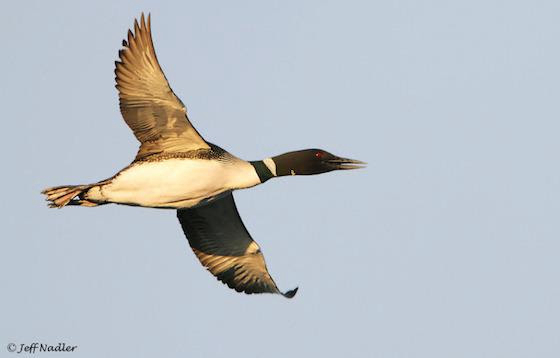 Common Loon migration behavior provides some interesting looks into the species (photo by Jeff Nadler). |
When do loons begin migration? A study of Common Loons in Maine and New Hampshire banded most of the individuals of 32 pairs of loons they studied so researchers could identify and study the behavior of individual loons. Overall, there was a lot of variability in the timing of loon departures from New England lakes, but there were also some general trends. Some adults start to leave their nesting lakes in September, while others stick around until late November. Fledglings tend to depart in late October and November.
Some of the study’s major findings include:
– Adult Common Loons left separately; 62 percent of the time the female departed first.
– When the first adult departed in early September, the youngest fledgling was 8 weeks old.
– The average age of fledglings when the last adult departed was 17 weeks old.
– Among 2 broods of loon fledglings, 1 fledgling occasionally left before the second adult.
– On average, the last fledgling left 3 days after the last adult left. There were 3 cases in which the fledgling left 22 to 37 days after the last adult. The departure of the last adult might be a signal for the fledgling to also leave, but not always.
Most Common Loons that nest in New England spend the winter off the Northeast coast of the United States, which requires only a short migration period of 1 to 2 days. However, a satellite telemetry study that tracked a Common Loon fledgling that left its natal territory in Adirondack, (New York) in late November that took 56 days to fly from lake to lake until it eventually reached Long Island Sound in January. Young Common Loons usually spend several years on the ocean before returning to their natal lake region.
Common Loons that nest in the central region of North America overwinter along central and southeast coasts and the Gulf of Mexico, so they have a lot further to fly than New England’s loons! One field study that followed 2 Common Loons from Saskatchewan revealed that one loon migrated to Lake Michigan, then straight south to the Gulf of Mexico. The second loon flew to the same location in the Gulf of Mexico, but migrated via Lake Erie, the Chesapeake Bay, then south, eventually crossing the Florida panhandle to the Gulf.
The few loons that have been studied using radio telemetry show a lot of variation, even among the few birds that have been studied over short periods of time. The information provided by the telemetry studies is extremely interesting and obviously points to the lack of information we have regarding Common Loon behavior, movements and migrations; and points strongly to the need for more indepth studies of this vulnerable species across its range.
To refer to the original article provided by the Vermont Center for Ecostudies, see https://vtecostudies.org/blog/loon-departure-times/
